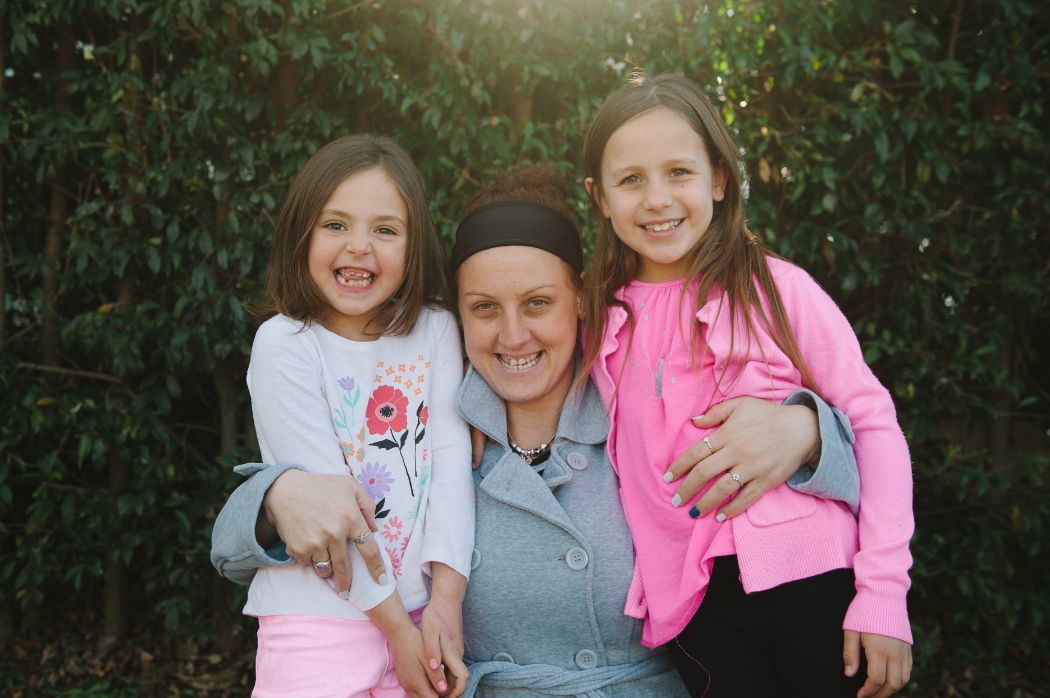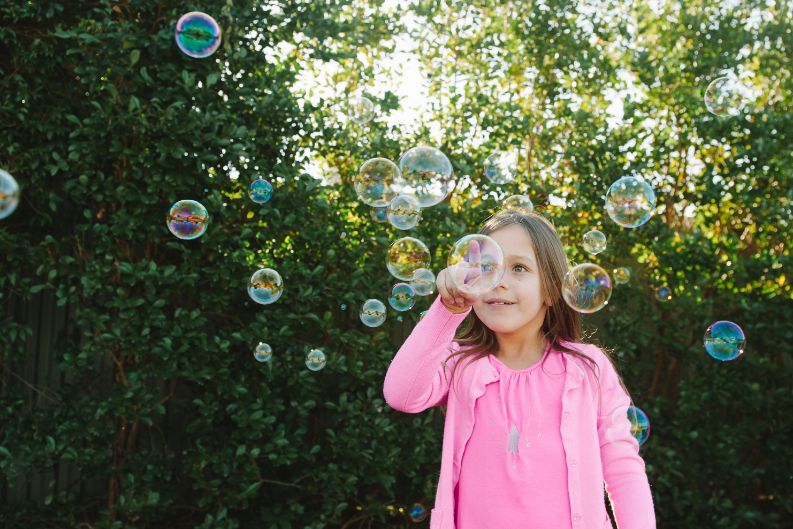Automatic language translation
Our website uses an automatic service to translate our content into different languages. These translations should be used as a guide only. See our Accessibility page for further information.

When I first met Kate in 2013, she was quiet and shy and relied on others to speak for her. But one thing was clear, Kate loved her girls and was fierce in her determination to have them back with her.
Her children, Cara and Beth, came into care in 2010. Cara was two and Beth was a newborn. Kate had a difficult childhood and she became a parent in early adulthood. Her partner was violent and controlling, and Kate seemed to have no supports outside the relationship. The girls were taken into care by DCJ because of Kate’s drug use and their father’s violence.
Cara and Beth were living with kinship carers, Becky and Tom. They had put their lives on hold to care for the girls and loved them dearly. Cara and Beth were thriving and seemed happy and secure. When I spoke with Becky and Tom about the possibility of the girls returning to their mum, they were supportive, even though it would mean the girls not being with them every day.
In the meantime Kate had made significant changes in her life, on her own, and without any involvement from DCJ. She ended the relationship with the girls’ father, saw a psychologist, and went to counselling. She stopped using drugs and she attended a few different parenting programs.
When I met Kate she was in a new relationship with James. This relationship seemed different, more mutual and came with a support network of family. James was also supportive of Kate’s efforts to get her girls back.
When Kate got pregnant with her third child she was proactive with DCJ. She asked to meet and told us about all the things she had done to improve her parenting. Baby Laura was born safe. She was well cared for and loved by both her parents. There was no need for DCJ involvement with Laura.
I knew the family history from the file and what Kate told me. I saw evidence of the real changes Kate had made in her life. There had been no further worries about drug use and Kate had been proactive with prenatal care. Kate and James had been ready for Laura’s birth. I also saw the way they worked together to care for this new baby. Kate was doing so well that I came to think she was right. The best place for Cara and Beth was with their mum, James and their baby sister.

The Children’s Court process began. It was a big decision, to move two young children who were doing well and appeared to have a warm and loving relationship with their carers. For this reason we asked for a court clinican to assess the girls’ attachment to their carers. We wanted the clinician to consider what it would mean for the girls to return to their mum’s care. The clinican’s assessment wasn’t negative about Kate and James, but it was in favour of the girls remaining with Becky and Tom. I was disappointed and frustrated. I felt the girls’ best interests were not being considered. Kate was devastated.
My manager and I consulted every professional we could about whether or not to keep going. Could we go against the recommendation of a court clinician? Were Cara and Beth better off staying with Becky and Tom? The girls did have a secure attachment to them, so would it be harmful for the girls to return to their mum’s care? We really struggled with this decision.
Ultimately, the changes Kate had made, Cara and Beth’s warm and positive relationship with her and Kate’s determination to get her girls back was enough evidence for us to support them returning to live with mum. Baby Laura was thriving with Kate and James. Cara and Beth now had a baby sister so why couldn’t the whole family be together?
When we told Kate that our decision was to support the girls living with her she was shocked. As part of the process, and with Kate’s agreement, we referred her to an intensive restoration program. This required Kate to travel with baby Laura by train three days a week for a period of 18 months. It was a massive commitment, but it paid off. The Children’s Court agreed that the girls should live with Kate, Laura and James.
During this time I became a prenatal caseworker. All the children and families I had been working with were reallocated to other caseworkers. I argued strongly with management to continue my work with Kate, Cara and Beth. Thankfully this was supported. I wanted to stick with this family and see the restoration through.
Restorations are hard. I had built a good relationship with the family, the girls and their carers. I wanted to give them all the support they needed during that incredibly important transition.
In order to make the restoration as smooth as possible we agreed to a planned transition for the girls to return home. Cara and Beth went from spending the day with Kate, to overnight sleepovers, then weekend sleepovers before the final move to full time care with Kate and James. Over the next 12 months I continued to visit once a month, but towards the end there really was no need because Kate and James were doing such a fantastic job. Cara and Beth continue to see Becky and Tom regularly, and still have that strong relationship. Kate, Becky and Tom worked out the arrangements between them.
The day DCJ supervision order for the girls expired was very emotional. I went with a worker from one of the support services to Kate’s house for a final visit. To celebrate we took a cake. It was such a happy moment. Kate and I had a big cry. Kate gave us each a bunch of flowers and a card. I had brought two small canvases with me. We all put our handprint on each canvas. One canvas was for Kate and the girls, and the other for me. I keep mine on my desk at work.
I am so proud of Kate; all she has achieved and the difficulties she has overcome. Kate has blossomed into a confident woman who is able to stand up for both herself and her girls. Kate loves those girls. Her strength, hard work, determination and courage is an inspiration for other mums.
When my girls were taken by DCJ, it was like my heart was ripped out. I had nothing left. But I knew that I had to keep going, because I couldn’t live a life without my kids. I was motivated from the very beginning. I was busy all the time, going to programs and mothers’ groups. I was working so hard to get my girls home. Sometimes I didn’t think I would make it. But my kids and supports at home kept me motivated.
I was worried I wouldn’t have a chance at getting the girls back. I didn’t know if I would get anywhere; but once I applied, I told myself this was it. I was going to get my girls back! That is when Lisa became my caseworker.
The girls had been in care for three years and during that time we had lots of different caseworkers. I was nervous about having another one, but Lisa turned out to be different. She made me feel like she believed in me. For a long time no one did. With Lisa it was a good relationship. We communicated honestly. It made it so much easier.
When the court clinician’s assessment report came back saying the girls should stay with Becky and Tom I was shattered. I thought I had no hope of getting my girls back. But Lisa believed in me and trusted me. DCJ was going to support the restoration anyway.
There are no words to describe how it felt when the court said my girls could come home to me. It was the best day of my life. I didn’t think I was good enough. I didn’t think I was going to be able to prove I could do it. But I did.
I feel free now. It was a long journey, and I didn’t think I would ever get there. But it’s a new beginning for my family. Every day I wake up and see my beautiful kids and I am the proudest mother in the world. I don’t need anything else. I’ve got everything I need right here in front of me.
Executive Director, Strategic Policy
Restoration is hard work. This story reminds us just how hard that work is for everyone involved. Lisa, Kate, James, Becky and Tom all had important roles to play. It was also asking a lot of Cara, Beth and Laura to get used to a different family life.
For Lisa some of the hard work was having to hold together her obvious compassion for Kate with the need to make sure that decisions are in the best interests of Cara and Beth. I see in Lisa the cool head and warm heart that is so important when working with families.
To her credit, Kate has done the hardest work of all. Personal change takes enormous strength. Kate needed to keep up her own self belief and then convince others that she was ready. As I read this story, I kept returning to image of Kate and baby Laura travelling on a train three days a week for 18 months to attend a restoration program. I wondered how far she had to travel and if the system could have been designed to provide support in ways that might have made Kate’s work just a bit easier.
What I like most about this story is the relationships. Kate and Lisa clearly worked as a team and have a great deal of respect for one another. The adults in Cara, Beth and Laura’s lives clearly love them and work together. That is the fierce love that creates a family.
16 May 2023